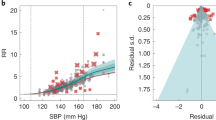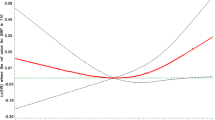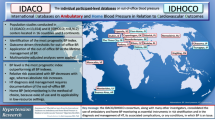Abstract
Since the middle of the 20th century, most physicians and epidemiologists assessed the risks associated with hypertension based on the level of diastolic blood pressure (DBP). In a classic paper in 1971, the Framingham Heart Study clearly showed that systolic BP more accurately described the risk of all the complications we attribute to hypertension. It took 22 years until JNC V in 1993 also used systolic blood pressure (SBP) to define hypertension in US national guidelines. Since then, the paradigm has shifted dramatically. In JNC VI (1997) and JNC VII (2003), SBP has become the primary focus of risk stratification and treatment goals. This shift is a result of the Framingham results being confirmed by many others analyses, the most compelling of which is the recently published report of the Prospective Collaborative Study Group, which pooled 61 observational studies in more than 1 million volunteers with a collective experience of more than 12 million person-years. This group showed that the SBP level at baseline was a significantly more informative reading than DBP for predicting strokes and coronary heart disease (CHD). Furthermore, three trials of older individuals with isolated systolic hypertension, SHEP, SYST-Eur, and SYST-China, unambiguously demonstrated that effective antihypertensive therapy lowered the rate of strokes, heart failure, CHD, and even all-cause mortality. Finally, the World Health Organization (WHO)/International Society of Hypertension (ISH) Hypertension Trialists also showed that the level of SBP achieved in clinical trials comparing different antihypertensives with placebo and with each other was the strongest determinant of how effectively strokes and CHD events were reduced, although a similar relationship was not evident for heart failure. A recent metaregression analysis using new trials, many of which were used by the Trialists, and older studies not included in their analysis also showed that small differences in SBP can have a dramatic impact on cardiovascular outcomes. If there is one thing we have learned in the recent past, it is the need for us to focus on lowering SBP and getting it down to a reasonable goal. We have also learned that to do so, we will need to combine a variety of lifestyle and pharmacological approaches, always with combinations of drugs that will usually contain a low-dose thiazide-type diuretic with other antihypertensives.
This is a preview of subscription content, access via your institution
Access options
Subscribe to this journal
Receive 12 digital issues and online access to articles
$119.00 per year
only $9.92 per issue
Buy this article
- Purchase on Springer Link
- Instant access to full article PDF
Prices may be subject to local taxes which are calculated during checkout





Similar content being viewed by others
References
The Pooling Project Research Group. Relationship of blood pressure, serum cholesterol, smoking habit, relative weight and ECG abnormalities to incidence of major coronary events: final report of the Pooling Project. J Chronic Dis 1978; 31: 201–306.
Veterans Administration Cooperative Study Group on Antihypertensive Agents. Effects of treatment on morbidity in hypertension. II. Results in patients with diastolic blood pressure averaging 90 through 114 mmHg. JAMA 1970; 213: 1143–1152.
Hypertension Detection and Follow-up Program Cooperative Group. Five-year findings of the hypertension detection and follow-up program. II. Mortality by race–sex and age. JAMA 1979; 242: 2572–2577.
Amery A et al. Mortality and morbidity from the European Working Party on high blood pressure in the elderly trial. Lancet 1985; 1(8442): 1350–1354.
Report of the Joint National Committee on Detection, Evaluation, and Treatment of High Blood Pressure. A cooperative study. JAMA 1977; 237: 255–261.
The 1980 report of the Joint National Committee on Detection, Evaluation, and Treatment of High Blood Pressure. Arch Intern Med 1980; 140: 1280–1285.
The 1984 Report of the Joint National Committee on Detection, Evaluation, and Treatment of High Blood Pressure. Arch Intern Med 1984; 144: 1045–1057.
The 1988 Report of the Joint National Committee on Detection, Evaluation, and Treatment of High Blood Pressure. Arch Intern Med 1988; 148: 1023–1038.
Kannel WB, Gordon T, Schwartz MJ . Systolic versus diastolic blood pressure and risk of coronary heart disease. The Framingham study. Am J Cardiol 1971; 27: 335–346.
Joint National Committee on Detection, Evaluation, and Treatment of High Blood Pressure: The Fifth Report of the Joint National Committee on Detection, Evaluation, and Treatment of High Blood Pressure (JNC V). Arch Intern Med 1993; 153: 154–183.
The Sixth Report of the Joint National Committee on Prevention, Detection, Evaluation, and Treatment of High Blood Pressure. Arch Intern Med 1997; 157: 2413–2446.
Chobanian AV et al. National Heart, Lung, and Blood Institute Joint National Committee on Prevention, Detection, Evaluation, and Treatment of High Blood Pressure. National High Blood Pressure Education Program Coordinating Committee. The Seventh Report of the Joint National Committee on Prevention, Detection, Evaluation, and Treatment of High Blood Pressure: the JNC 7 report. JAMA 2003; 289: 2560–2572.
Lewington S et al. Prospective Studies Collaboration. Age-specific relevance of usual blood pressure to vascular mortality: a meta-analysis of individual data for one million adults in 61 prospective studies. Lancet 2002; 360: 1903–1913.
Burt VL et al. Prevalence of hypertension in the US adult population: results from the Third National Health and Nutrition Examination Survey, 1988–1991. Hypertension 1995; 25: 305–313.
Franklin SS et al. Hemodynamic patterns of age-related changes in blood pressure. The Framingham Heart Study. Circulation 1997; 96: 308–315.
Franklin SS . Ageing and hypertension: the assessment of blood pressure indices in predicting coronary heart disease. J Hypertens 1999; 17(Suppl 5): S29–S36.
SHEP Cooperative Research Group: Prevention of stroke by antihypertensive drug treatment in older persons with isolated systolic hypertension. Final results of the Systolic Hypertension in the Elderly Program (SHEP). JAMA 1991; 265: 3255–3264.
Staessen JA et al. Randomised double-blind comparison of placebo and active treatment for older patients with isolated systolic hypertension. The Systolic Hypertension in Europe (Syst-Eur) Trial Investigators. Lancet 1997; 350: 757–764.
Liu L et al. Comparison of active treatment and placebo in older Chinese patients with isolated systolic hypertension. Systolic Hypertension in China (Syst-China) Collaborative Group. J Hypertens 1998; 16(12 Part 1): 1823–1829.
Staessen JA et al. Risks of untreated and treated isolated systolic hypertension in the elderly: meta-analyses of outcome trials. Lancet 2000; 355: 865–872.
Blood Pressure Lowering Treatment Trialists’ Collaboration. Effect of different blood pressure lowering-regimens on major vascular events: second cycle of prospectively-planned analyses from the Blood Pressure Lowering Treatment Trialists’ Collaboration. Lancet 2003; 362: 1527–1536.
Staessen JA, Wang JG, Thijs L . Cardiovascular prevention and blood pressure reduction: a quantitative overview updated until 1 March 2003. J Hypertens 2003; 21: 1055–1076.
Singer GM, Izhar M . Black HR for the Rush University Hypertension Service. Goal-oriented hypertension management: translating clinical trials to practice. Hypertension 2002; 40: 464–469.
Singer GM, Izhar M . Black HR for the Rush University Hypertension Service. Guidelines for hypertension: are quality assurance measures on target? Hypertension 2004; 43: 1–5.
Black HR et al. for the CONVINCE Research Group Principal Results of the Controlled Onset Verapamil Investigation of Cardiovascular Endpoints (CONVINCE) Trial. JAMA 2003; 289: 2073–2082.
Cushman WC et al. for the ALLHAT Research Group Success and Predictors of Blood Pressure Control in Diverse North American Settings: The Antihypertensive and Lipid-Lowering Treatment to Prevent Heart Attack Trial (ALLHAT). J Clin Hypertens 2002; 4: 393–405.
Author information
Authors and Affiliations
Rights and permissions
About this article
Cite this article
Black, H. The paradigm has shifted to systolic blood pressure. J Hum Hypertens 18 (Suppl 2), S3–S7 (2004). https://doi.org/10.1038/sj.jhh.1001795
Published:
Issue Date:
DOI: https://doi.org/10.1038/sj.jhh.1001795
This article is cited by
-
Influence of baseline arterial stiffness on effects of intensive compared with standard blood pressure control: a post hoc analysis of the STEP trial
BMC Medicine (2022)
-
Renal size and cardiovascular risk in prepubertal children
Scientific Reports (2019)
-
High blood pressure and hypertension in children with newly diagnosed acute leukemia and lymphoma
Pediatric Nephrology (2008)
-
Treatment of isolated systolic hypertension
Current Hypertension Reports (2006)



